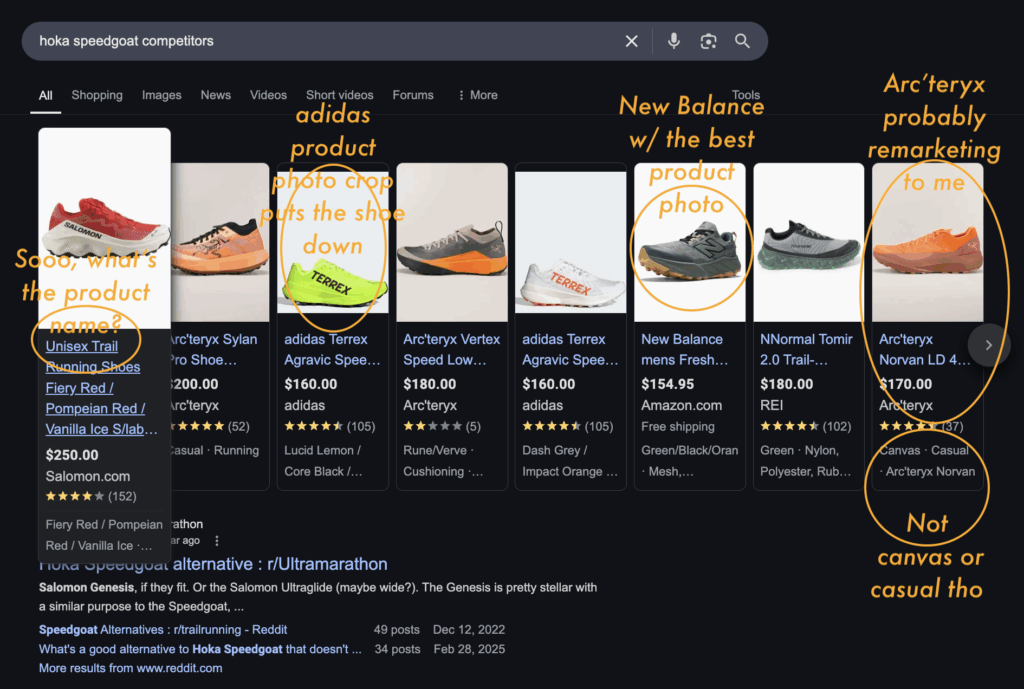
Search engine marketing doesn’t get the design & copywriting attention a print ad would, even though it likely reaches a far greater percentage of the audience, and drives more engagement.
There’s a lot of agencies, tools, and tutorials focused on optimizing PPC budgets to the nth degree, a valuable pursuit to be sure, but meanwhile we’re missing some eCom basics like *showing the product & brand name* or cropping the product pic correctly, or listing the correct product features.
Don’t forget: more customers will see these ads than your social posts or print ads.
Nail the brand basics and consider the below needs before pushing your agency or PPC manager too aggressively towards technical efficiency:
1. Highly Specific Targeting
There are riches in the niches, as the saying goes, and in those niches nuance is everything. A trail runner’s expectations differ from that of a casual hiker. Your product pages surely reflect that, and your PPC campaigns will be more successful if they do as well.
Keywords & Ad Copy/CTA Alignment:
SEM offers direct access to people actively looking for “best women’s trail running shoes for rocky terrain” or “ultralight waterproof hiking jacket.” These long-tail, high-intent searches are flecks of gold in the internet’s muddy river. Sift them out with laser-focused ad copy and clear, action-oriented calls to action—like “Shop Rock-Ready Trail Runners” or “Stay Dry, Stay Light. Shop Now.” Matching the searcher’s language in the headline copy and closing with a rephrasing in the CTA can get the right type of click: one with purchase intent.
Location Targeting:
Geo-targeting is especially useful for regional weather-based campaigns or events. If you’re promoting puffy jackets, focus on regions currently experiencing (or about to!) low temps. Got an in-store activation in Bend, Oregon? Bid higher in that zip code in advance to build awareness and foot traffic. Or favor media-centric major metros (hello NYC) to bolster PR campaigns. Angling for a big collab with another brand? Target their offices’ zip codes too.
Demographics:
If you’re selling high-performance apparel it makes sense to target 25–44-year-olds with disposable income and active lifestyles, sure. But you can get even more granular: find your audiences’ most influential segment and increase your bids there.
Look-Alike Audiences:
Use your first-party data to find more of your best customers. Upload lists of high LTV customers and let Google’s Similar Audiences help you scale.
2. A Frictionless Conversion Funnel
Who hasn’t scrolled past a search ad from an unknown brand, or clicked and hit the back button when the page disappointed, or worse, didn’t load?
Brand Recognition:
Generally speaking the conversion funnel starts before your search ad is viewed. Unless you’re selling emergency services (plumbers & locksmiths know what I mean), or takeout food a la “thai food to go near me,” customers should know who you are before you appear in their SERP. That’s SEM-speak for Search Engine Results Page.
Landing Page Alignment:
Once someone clicks, the clock starts ticking. Every 10-millisecond delay, any vague headline or mismatched image adds friction, costing conversions.
Offer Attractiveness:
The right incentive can be the nudge someone needs to convert. Sometimes a reminder suffices: “Free, Easy 30-Day Returns.” Generally it pays to reduce budgets in the run-up to a seasonal sale, then boost spend while your prices are at their best, provided you’ve got the margins or customer LTV to support it. Urgency makes any offer more attractive: holiday gift shopping, or say, pre-Memorial Day camping purchases are the obvious times for SEM to shine.
3. Integration with Broader Strategy
PPC should not exist in a vacuum. The best SEM programs are plugged directly into your broader marketing, storytelling, and growth efforts.
Brand Marketing Alignment:
People may first encounter your brand through a podcast, an Instagram ad, or a film about backcountry skiing. But when they’re getting ready to buy, they’ll likely turn to Google. Don’t let that moment slip. Bidding on branded search terms—yes, your own name—ensures consistency and helps reinforce the story you’ve already begun to tell.
Remarketing & Lifetime Value:
Any higher cost or lower-urgency purchase will likely involve multiple Google searches, and page views. Use remarketing lists for search ads (RLSAs) to show refined messaging to past visitors—such as highlighting durability, warranty, or fit guarantee. Post-purchase, continue engaging them with cross-sell campaigns (e.g. “Complete Your Trail Kit”) to grow lifetime value.
Strategic Audience Building:
SEM can also be a tool for building relationships with strategically important groups—race directors, gear reviewers, or those traveling to a particularly trendy destination or event. Not every campaign needs to convert immediately. Sometimes, the goal is to build credibility and top-of-mind awareness within circles that influence broader customer behavior. For the most strategically important audiences, use SEM to drive micro-conversions. like email sign-ups, video views, or simple engaged sessions.
Last modified: May 6, 2025